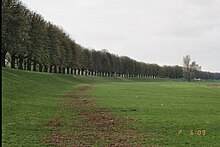Gnadental (Neuss)
|
Gnadental District 8 of Neuss |
|
|---|---|
| Coordinates | 51 ° 10 '53 " N , 6 ° 43' 7" E |
| surface | 2.20 km² |
| Residents | 5140 (June 30, 2014) |
| Population density | 2336 inhabitants / km² |
| Post Code | 41468 |
| prefix | 02131 |
| Borough | Gnadental (8) |
| Transport links | |
| Highway |
|
| Federal road |
|
| Bus lines | 841 849 851 852 854 874 875 |
| Source: Timetable information from Stadtwerke Neuss | |
Gnadental is a district of the district town of Neuss . With an area of 2.20 km² and 5,112 inhabitants (as of June 30, 2011), Gnadental is one of the medium-sized districts. Although large parts of it were not built until after the Second World War , the district looks back on a long history.
history
At 16 BC The Romans built the extensive legionary camp Novaesium of the VI on the Heerstrasse between Cologne and Xanten . Legion, which was occupied until the middle of the 4th century. There was also a Cybele cult site , which was excavated in 1956. The first post-Roman settlement and an associated burial ground are about 750 meters southwest of the Roman camp.
Around 1250 a Cistercian convent was built in the Vallis Gratiae (Valley of Grace) .
Main article Gnadental Monastery (Neuss)
The more than 550-year history ended in 1802 with the Napoleonic secularization . The monastery became the Gnadental estate. In 1945 the property was 70% destroyed by American air raids. The remains of the building were restored in 1996 and are now used as the Zülow conference venue.
Line 1 of the Neuss tram ran from 1925 to 1971 in the east of Gnadental .
religion
The parish church of St. Konrad is located in Gnadental . The consecration took place on April 20, 1958. The church of the Protestant community is the Kreuzkirche.
Economy and culture
Today's Gnadental is economically rather insignificant, but a popular residential location, both because of the good transport connections and because of the high recreational value. Despite its name, the Grimlinghausen sports harbor does not belong to the Grimlinghausen district , but to Gnadental. The area around the sports harbor, together with the stadium district, is one of the most expensive residential areas in Neuss.
societies
The district is characterized by a rich club life, which determines the social life of the "green district of Neuss". The clubs include the DJK Gnadental football club and the Neuss-Gnadental e. V. You can also play football on an artificial turf and a natural grass field, and tennis on six clay courts.
Public transport
Gnadental is connected to the Neuss city bus network by seven bus routes, which run on two axes from the center of Neuss through Gnadental. On the one hand there is the Kölner Straße, which is used by the bus routes in the direction of Grimlinghausen, and the Berghäusensweg, on which the lines in the direction of Weckhoven and Erfttal run. As a special feature, line 849 coming from Neuss leaves Kölner Strasse after the Humboldtstrasse stop and crosses Gnadental tangentially before turning onto Berghüllenensweg at the Weißdornweg stop.
Via Kölner Strasse
| line | Line course |
|---|---|
| 849 | Lukaskrankenhaus - Stadionviertel - Neuss main station - Stadthalle - Gnadental - Erfttal |
| 851 | Kaarst - Neusserfurth - Neuss main station - Stadthalle - Gnadental - Grimlinghausen - Üdesheim |
| 852 | Kaarst - Neusserfurth - Neuss Central Station - City Hall - Gnadental - Grimlinghausen - Norf |
| 875 | Landestheater - Gnadental - Grimlinghausen - Stüttgen - Stürzelberg - Zons - Dormagen Bf |
Via Berghäusensweg
| line | Line course |
|---|---|
| 841 | D-Heerdt, Handweiser - Neuss Furth - Neuss Central Station - City Hall - Gnadental - Norf - Rosellen - Rosellerheide |
| 854 | Vogelsang - Weissenberg - Neuss Central Station - City Hall - Gnadental - Selikum - Reuschenberg - Weckhoven |
| 874 | Rheinparkcenter - Hafen - Stadthalle - Gnadental - Norf - Rosellen - Gohr - Broich - Vanikum |
Web links
- Citizens and local history association Neuss-Gnadental eV
- Basic statistical data for the city of Neuss
- Historical illustration by Frans Hogenberg : Gnadendall ( digitized version )
Individual evidence
- ↑ G. Müller, in: Stadt Neuss (ed.), The Roman Neuss. Stuttgart 1984
- ^ Frank Siegmund: Merovingian time on the Lower Rhine. Rhenish excavations 34. Rheinland-Verlag, Cologne 1989, 300 f.
- ↑ See Neuss city timetable, available at https://www.stadtwerke-neuss.de/nahverkehr/fahrplan






